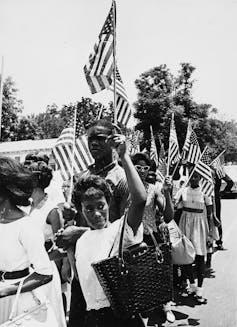by Marlee Bunch, University of Illinois at Urbana-Champaign
My grandmother’s name was Mrs. Zola Jackson.
As one of the handful of Black teachers in Mississippi during the Jim Crow era of racially segregated public schools, she faced a daunting challenge in providing a first-class education to students considered second-class citizens.
Educated at Rust College, a historically Black school, in the 1940s, she taught in the small city of Hattiesburg for over 30 years from 1943-1975, the majority of which was spent in elementary classrooms at DePriest, the school for Black children.
Before the 1954 landmark Brown v. Board decision that deemed segregated schools “separate and unequal,” the efforts of Black teachers went unheralded, underappreciated and virtually unknown.
I, too, was disconnected from their stories until I became a public school teacher teacher myself and began my research on the oral histories of Black female teachers in Mississippi during the civil rights era.
My research revealed at least one important lesson: What Black teachers face today is not that different from what we faced in the past.
In spite of it all
One of the initial questions that I wanted to answer was, how did educators in the past meet the academic and emotional needs of their students with little to no resources and the constant threat of racial violence?
What I found was that for Black people, education was in and of itself an act of active resistance against racial disenfranchisement.
As education scholar Christopher Span explained in his 2012 seminal book “From Cottonfield to Schoolhouse”:
“To be educated was to be respected; to be educated was to be a citizen. Accordingly, countless black Mississippians willingly sought out schooling, viewing it as the foundation for self-improvement and one means for attaining social and economic parity in slavery’s aftermath.”
At the center of that rich and complex history were Black teachers who believed that a good education was synonymous with freedom and the desire to move beyond the confines of second-class citizenship.
As a result, Black teachers used classrooms to not only impart the lessons of history, but also to encourage students to be actively involved in the fight for racial equity.
In “Their Highest Potential,” education scholar Vanessa Siddle Walker wrote in 1996 that Black teachers were “consistently remembered by their former students and colleagues “for their high expectations for student success, for their dedication, and for their demanding teaching style.”
Education was paramount
Black teachers used many approaches to ensure student success. Here are a few that serve as lessons for today:
Arguably the most important, the first is developing relationships and mentorships.
Because teachers were part of the community during the civil rights era, it was common for them to be an extension of their students’ families. If needed, teachers made home visits, were in regular communication with families about students’ well-being and held students to high academic and behavioral expectations. Further solidifying those relationships was the fact that many of the teachers had taught several generations of families.
These relationships enabled teachers to use what is now known as the whole child approach that focuses on a student’s academic potential as well as their social and emotional needs.
It was understood by Black teachers that educating the whole child helped to establish foundations needed for academic and emotional growth in young students. Because of their teachers, Black students valued education and modeled their own behavior to achieve their own potential.
A second lesson from the past that is useful today was the emphasis on civic engagement. Back then, classrooms were places to imagine radical change. Inaction in the face of injustice was not a viable option, and there was an expectation that young people work to become leaders.

Archive Photos/Getty Images
Going to jail, protesting, risking one’s life and making sacrifices to help the Civil Rights Movement were all realities young people faced and were willing to endure if it meant securing equal rights.
A third lesson is the importance of building coalitions across racial lines.
Groups such as the Student Nonviolent Coordinating Committee, the NAACP and the Congress of Racial Equity worked with religious organizations and white students from colleges during the 1960s lunch counter sit-ins and the freedom rides, as well as the 1963 March on Washington for Jobs and Freedom.
But not all coalitions were effective. During a 1967 meeting of the National Council of Negro Women, civil rights activist Fannie Lou Hamer criticized the educated middle-class Black alliances in Mississippi with Black ministers and white power brokers. But even still, she explained, “the only thing we can do is to work together.”
Of the many lessons from the past, one handed down from my grandmother still rings true today.
She knew then that education was intended to be the great equalizer in America and the key to upward mobility – and she worked her entire career making sure that became a reality in Hattiesburg, Mississippi.
At the school where my grandmother taught, for instance, she used creativity to solve a critical problem: DePriest did not have a library.
Instead, my grandmother started her own by bringing in books from her personal collection and letting students borrow them one at a time.
Marlee Bunch, Staff K-12 Initiatives, Office of the Chancellor, University of Illinois at Urbana-Champaign
This article is republished from The Conversation under a Creative Commons license. Read the original article.